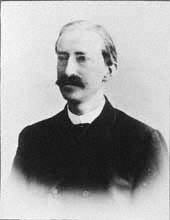George Arnold Escher
George Arnold Escher | |
|---|---|
 | |
| Born | 10 May 1843 |
| Died | 14 June 1939 (aged 96) |
| Nationality | Dutch |
| Occupation | Civil engineer |
| Spouses | Charlotte Marie Hartitzsch
(m. 1882; died 1885)Sara Gleichman (m. 1892) |
| Children | 5 sons, including: M. C. Escher Berend George Escher |
George Arnold Escher (10 May 1843 – 14 June 1939) was a Dutch civil engineer and a foreign advisor to the Japanese government during the Meiji period.[3][4]
He was the father of the graphic artist M. C. Escher and the geologist Berend George Escher.
Career[edit]
Escher was hired by the Japanese government as a foreign advisor from September 1873 to July 1878, along with fellow Dutch civil engineers Johannis de Rijke and Cornelis Johannes van Doorn.[3] During his stay in Japan, he designed and supervised the restoration of the Yodo river (Osaka), and built a harbour in Mikuni in Fukui prefecture.
Escher also collaborated on works in China with Johannis de Rijke, including works related to the sandbank at the mouth of the Huangpu Jiang. This tributary of the Yangtze River plays a crucial role in Shanghai's international trade.[5] Escher accompanied de Rijke on an exploratory visit to Shanghai and compiled a report that garnered considerable attention, though it did not culminate in immediate implementation.[6][7][8]
After returning to the Netherlands, he worked in Maastricht. During this time, he recorded in his diary his difficulty as a Protestant in finding a suitable marriage partner in Roman Catholic Maastricht who would also be able to satisfy his equation v = 1/2m + 10, where v was the age of the woman, and m the age of the husband.[9] In 1882, Escher married Charlotte Marie Hartitzsch, with whom he had two sons. He became a widower in 1885, and in 1892 married Sara Gleichman, with whom he had three more sons. Escher worked as a hydraulic engineer in Leeuwarden. In 1903 the family moved to Arnhem.[10][11]
Notes[edit]
- ^ https://www.openarch.nl/brd:8e756696-1bc3-6e7c-bc05-4f00b6433ff0
- ^ "Overlijdensakte George Arnold Escher". Gemeente Den Haag. 15 June 1939. hdl:21.12124/FEFB90EF6D9F46239B59905A24E10FFE.
- ^ a b Louman, Johannes. (2007). Fries waterstaatsbestuur, p. 127. , p. 127, at Google Books
- ^ van Gasteren, Louis, ed. (2003). Die Eeuwige Rijst met Japansche Thee: Brieven uit Japan van Nederlandse Watermannen, 1872–1903. Uitgeverij Bas Lubberhuizen. ISBN 9789059370241.
- ^ Yellow River Conservancy Commission, "Speech by Willem-Alexander, Prince of Orange," 2005; Archived May 22, 2011, at the Wayback Machine; retrieved 2013-4-5.
- ^ Tutein Nolthenius, R (1896-07-11). "Technische attché's" [Technical attaches]. De Ingenieur (in Dutch). 11 (28).
- ^ redactie (1896-07-11). "Vooruitzichten van Nederlandsche Ingenieurs in China}" [prospects for Dutch engineers in China]. De Ingenieur (in Dutch). 11 (28).
- ^ G. A. Escher, Johs. de Rijke (1894). "Woosung inner bar : with an appendix consisting of the report on the bar (1876)". Statistical Department of the Inspectorate General of Customs. Retrieved 9 December 2023.
CiNii Available at 1 libraries
- ^ "v = 1/2m + 10". Archived from the original on December 15, 2005. Retrieved June 5, 2007.
{{cite web}}: CS1 maint: unfit URL (link) - ^ Escher, G.A. (1981). Volume of the Biographical sketch & Memories of George Arnold Escher written after his retirement in 1910 & 1911. Mahone Bay, Canada.
{{cite book}}: CS1 maint: location missing publisher (link) - ^ Escher, M.C.; Bool, F. (1992). M.C. Escher: Life and Work. Harry N. Abrams. ISBN 978-0-8109-8113-3.
References[edit]
- Kamibayashi, Yoshiyuki. "Two Dutch Engineers and Improvements of Public Works in Japan," Archived 2014-03-21 at the Wayback Machine Proceedings of the Third International Congress on Construction History, Cottbus, May 2009.
- Louman, Johannes Petrus Antonius. (2007). Fries waterstaatsbestuur: een geschiedenis van de waterbeheersing in Friesland vanaf het midden van de achttiende eeuw tot omstreeks 1970. Amsterdam: Amsterdam University Press. OCLC 150391614
External links[edit]
- "w = 1/2m + 10". Archived from the original on December 15, 2005. Retrieved June 5, 2007.
- 御雇オランダ人工師エッセルの「阪井港修築建議」の現代文訳
Further reading[edit]
- Kamibayashi, Yoshiyuki (1999). "The Background of GA. Escher, Hollander Engineer who supported Jode Rijke for 40 years". Historical Studies in Civil Engineering. 19: 399–406. doi:10.2208/journalhs1990.19.399.
